Zeolite locality Pustý vrch u Folknářů, Czech Republic
Zeolite locality Pustý vrch near Folknáře (Czech Republic) is a highly productive locality of thomsonite-(Ca), phillipsite-(Ca) and gismondine-(Ca).
The main outcrop is located within the cadastral territory of the Dobrná village. However, the rocky cliffs with zeolites stretch over larger area at the edge of the Pustý vrch (Pustý hill) into cadastral territory of Březiny and Folknáře – which used to be standalone villages and now belong to Děčín town.

Beware that before 1939 older German names were regularly used. The Děčín was Tetschen and Pustý vrch might be referenced as Schiechenberg, Hornberg or Herrnberg.
Geology of the area
The locality is located within the Cenozoic volcanic area called České středohoří (České Středohoří Volcanic Complex), which hosts numerous zeolite localities. It is a hilly landscape with numerous hills formed by volcanic and volcano-sedimentary rocks piercing through mainly sedimentary rocks of Cretaceous age. The volcanism started by the opening of Ohře rift, which resulted in the intrusion of mostly basaltic magma in Miocene.
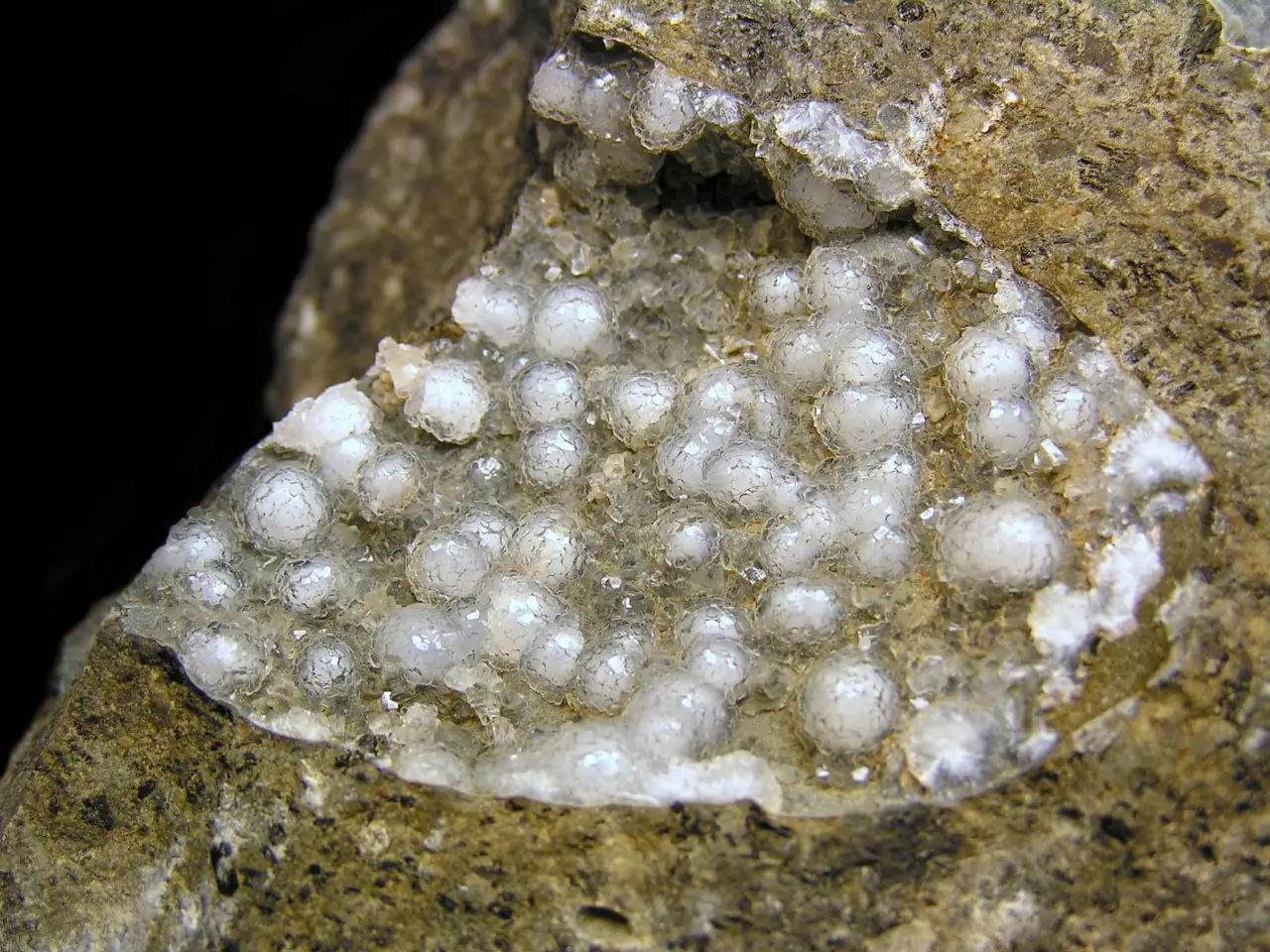
The volcano-sedimentary complex is prone to erosion. This resulted in dramatic change of the original landscape. In some parts, up to 300 m of rocks were eroded. The area is also crossed by the biggest Czech river Labe, which had serious influence on the geomorphology and above all caused the emergence of a series of landslide movements.
The original volcanoes and their surrounding sedimentary rocks were severely eroded. Most of the current outcrops of volcanic rocks are in fact remnants of the volcanic funnels and lava sheets.
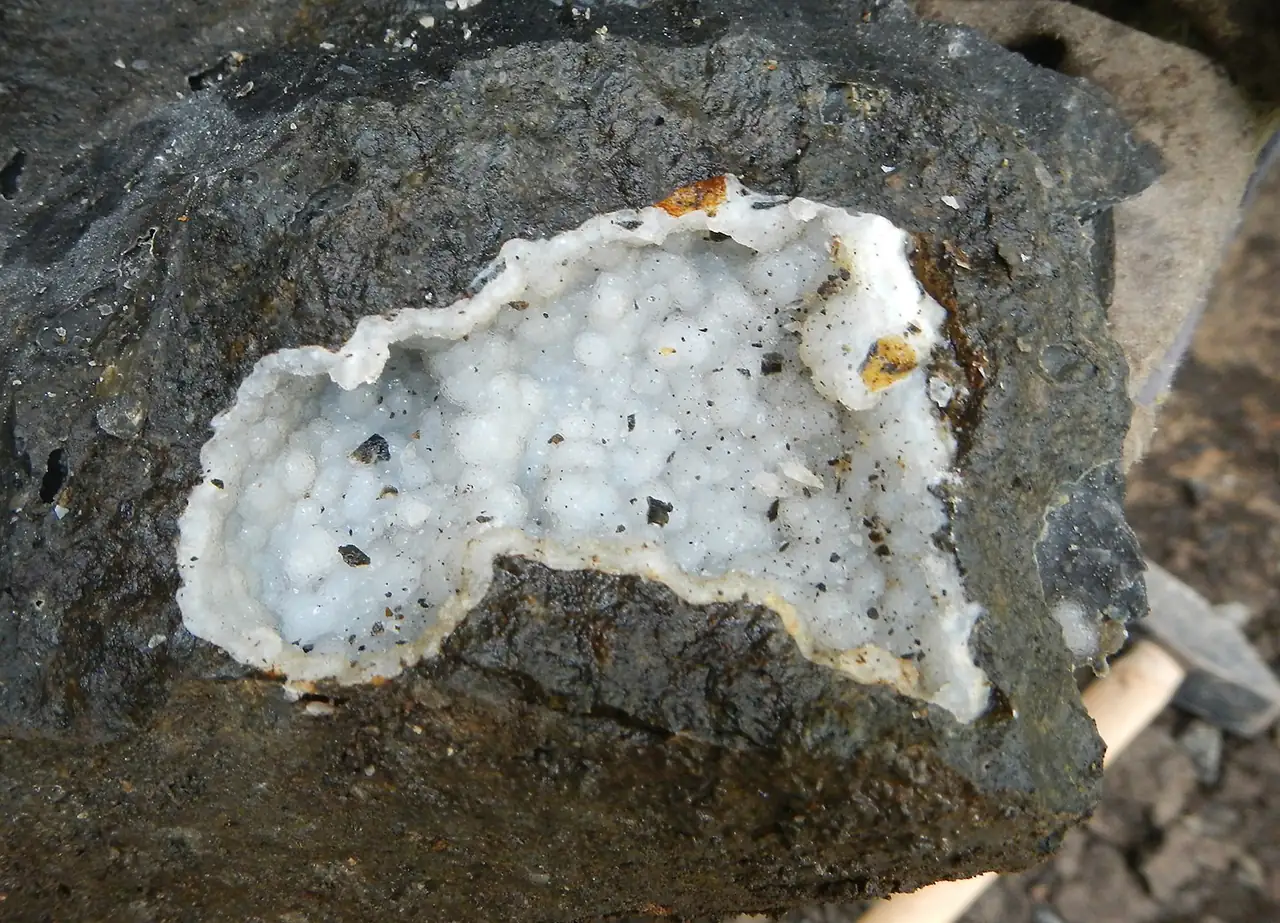
These volcanic rocks often contain abundant vesicles formed during decompression of the intruding rock. Many of these vesicles are filled with various zeolite minerals, calcite, analcime, apophyllite, opal and some other minerals. These mineral fillings were created due to hydrothermal activity in cooling or already fully cooled volcanic rocks.
Pustý vrch
The Pustý vrch is a hill (499 m.a.s.l) in between Folknáře, Březiny and Dobrná villages. The hill itself is a partially eroded volcanic funnel of Cenozoic volcano. According to the geological map, it is composed of alkaline basalt, locally with tephrite or augitite bodies or layers.
According to Cajz (Cajz et al. 1999), it is a relic of the so-called Děčín stratovolcano, but there is insufficient evidence for this theory. The dating of the adjacent Sokolí vrch (506 m.a.s.l) in same geological setting, was determined at 27.26 ± 0.39 Ma (Mysliveček et al. 2023).
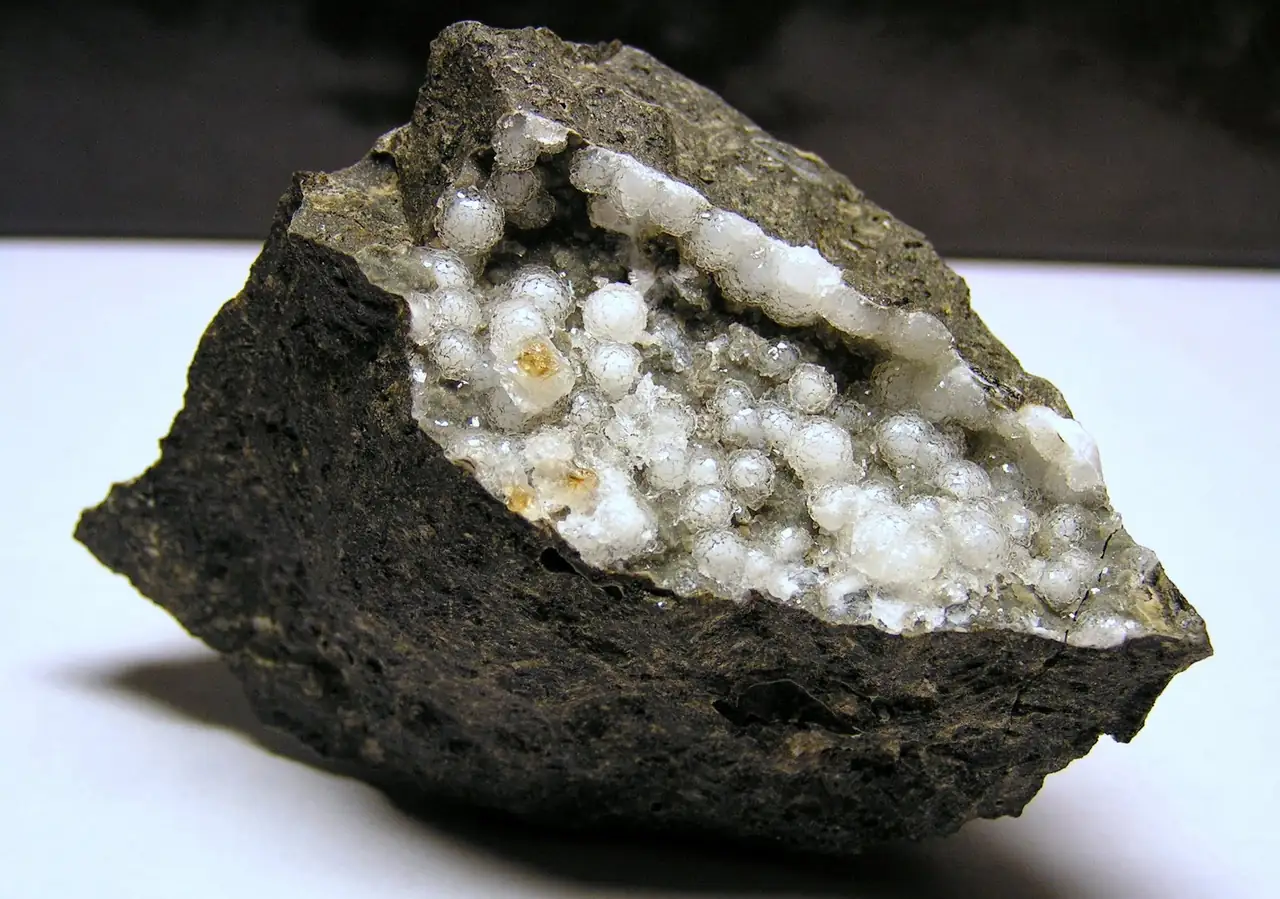
The zeolite outcrop with thomsonite was discovered in 1896 by Hibsch. It is located at the edge of the top flat platform of the Pustý vrch. The outcrop was probably created by the local quarrying activities in the 18th century.
The outcrop itself consists of three major parts: The bottom layer is made of a massive alkaline basaltoid. The middle layer is made of basaltoid with clinopyroxene phenocrysts and abundant volcanic vesicles. The top layer is composed of weathered light gray basaltoid. The top layer also contains vesicles, but often heavily damaged by weathering and filled with clay minerals.

The basaltoid is probably the same lava flow and the same rock in all three layers, but it shows different enrichment of voids after escaping gases and subsequent weathering. This rock has not yet been analyzed in modern days, but it's composition is probably alkali basalt/tephrite to trachybasalt.
Interesting geological feature at Pustý vrch is the presence of lava caves. One of these is likely in the discussed outcrop where minerals are regularly collected. However, it was damaged by the mining and the remnants were almost filled by rock debris.

These caves belong to pseudokarst cavities and were formed in two ways. The first (primary) way of formation is within volcanic tunnels, and the second (secondary) type of formation is caused by the gravitational instability of the slope resulting in the formation of fissure caves. The local inhabitants gave these caves the name Goblin Caves. The length of these caves does not exceed 20 m.
Mineralogy
The vastly prevailing mineral is thomsonite-(Ca), which is present in almost all volcanic vesicles. It forms clear columnar crystals up to 5 mm in size, some of them colored yellow, brown, or white.
More common are radial crystal sprays, forming the typical snowball shapes. These thomsonite balls usually have white core and clear rim with visible distinct crystal tops. This brings up the classic problem if the whole ball is really just thomsonite - many of such aggregates are composed of several zeolites. There is no modern analytical research done on these specimens yet.

Thomsonite balls are highly popular among mineral collectors. Typical size reaches 5-7 mm but balls up to 15 mm were found recently. However, there is a question as to whether these are not coatings of the original carbonate crystals. Inside these larger formations there is often a cavity with hints of crystal surfaces. Thomsonite is present in all three layers of the outcrop with the middle layer being the most productive.
Another aesthetic - yet often overlooked mineral - is phillipsite-(Ca). Tiny phillipsite crystals form crystalline strings and networks up to 3 cm in size. It is usually white or beige color, rarely also pale pink. These phillipsite crystalline strings is arguably the best in the whole České středohoří area. Phillipsite is also often present as microcrystalline coatings of the vesicles surface.

Less common is calcite. It either fills small vesicles up to 2 cm in size or forms rhombic crystals up to 5 cm. Calcite crystals are yellow, honey colored or brown and often grow on thomsonite balls.
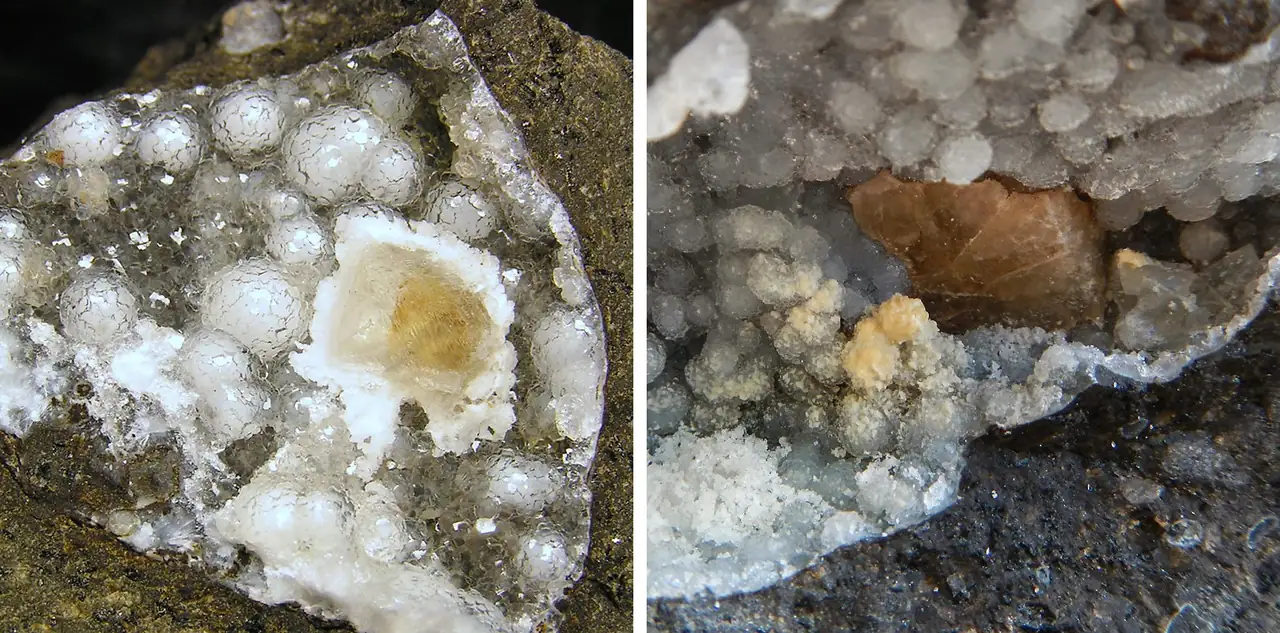
Quite rare mineral is gismondine-(Ca), which is often overlooked because of its tiny size. It occurs as pale colored coatings of microscopic crystal on the surface of the volcanic vesicles. Less common are crystals sized 1-3 mm in small vesicles bellow 4 cm in size, which occur only in the middle part of the outcrop. These gismondine crystals have typical pyramidal shape and white or clear color.
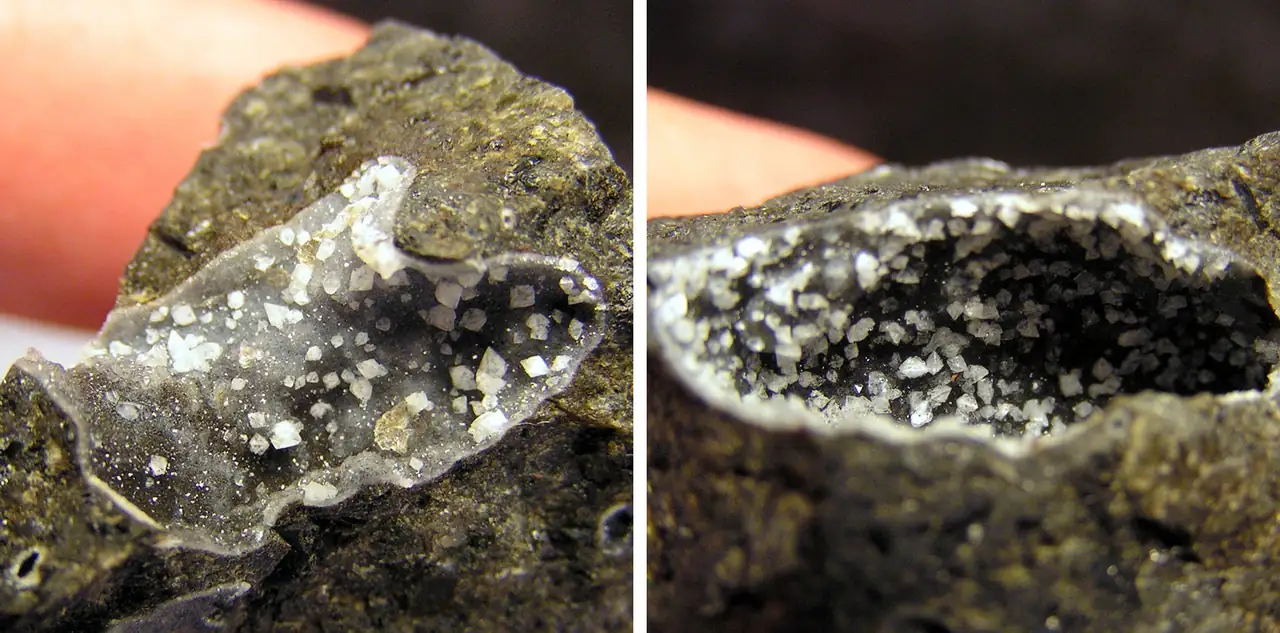
Natrolite is quite rare and forms thin white needles up to 5 mm long. However, its occurrence at the mentioned outcrop is disputable. All verified finds are from the same area, but different outcrops.
Current status
This locality is still very promising, but top finds require some serious work or lot of luck.
In the years 2016-2023, intensive collectors activity took place here in order to obtain collector's samples, which significantly affected the outcrop. This activity has not escaped the attention of the forest administration, and the collectors are also expelled from the locality if they are caught by forest administration workers. However, collecting in rock debris and loose rocks is permitted in the České středohoří.
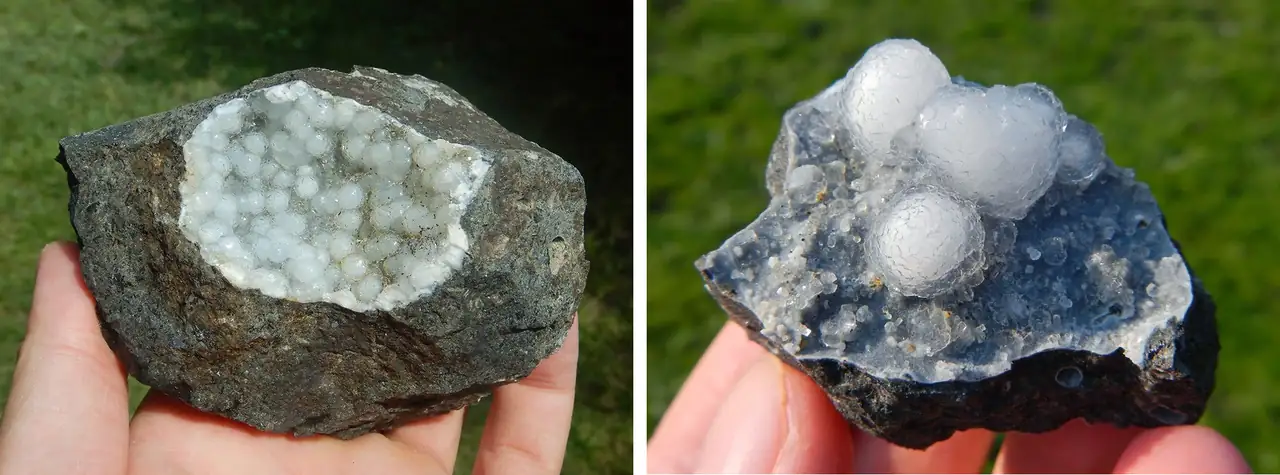
The most common is very abundant thomsonite, forming single crystals or typical thomsonite balls. Less frequent is phillipsite in the form of strings and webs formed by small crystals. Gismondine is present mostly in the forms of microscopic crystalline crusts in the vesicles, but less often forms also visible crystals 1-3 mm in size. Finding calcite or natrolite is quite uncommon.
The middle part of the outcrop yields the best quality specimens. However, it’s also composed of the very tough rock. Small crack hammer with normal size chisel is basically useless.
Plenty of fine specimens can be recovered from the piles of rocks bellow the outcrop. It just takes some time and lot of hammering. When picking up and breaking rubble rocks, you will need at least a 600g heavy hammer, but rather heavier tools are recommended.
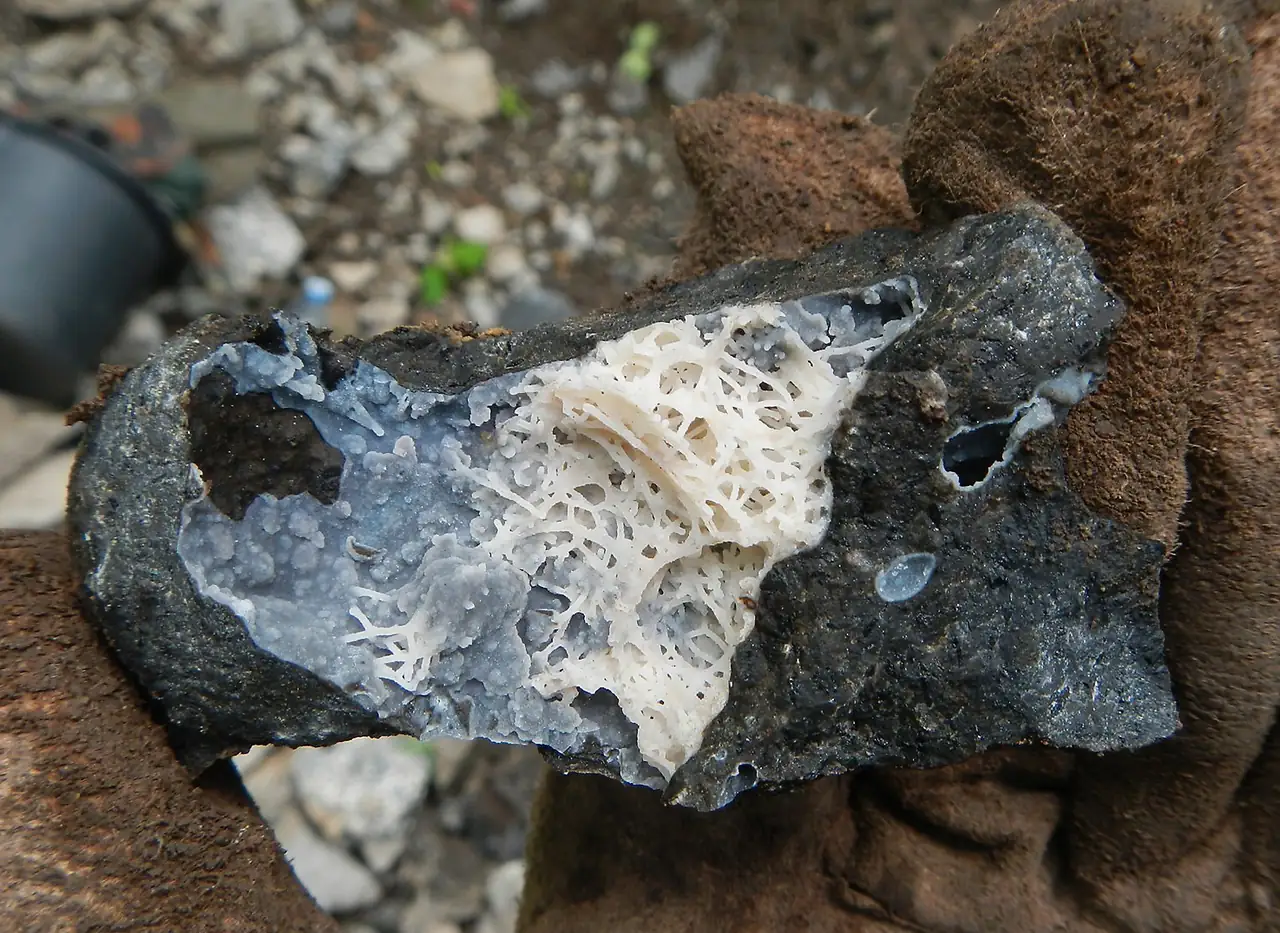
Make super sure to take safety goggles and sturdy gloves, the rock at this locality is very sharp!
There are numerous other places with zeolite minerals along the edge of the hill. However, the described outcrop is known as the best and most productive source.
References
- Cajz, V., Vokurka, K., Balogh, K., Lang, M., Ulrych, J., 1999. The České Středohoří Mts.: volcanostratigraphy and geochemistry. Geolines 9, 21–28.
- Dvořák Z., Radoň M., Svejkovský J., Janeček O., Dvořák P., Fuchs P. (2017): Minerály Českého středohoří. Muzeum města Ústí nad Labem. Ústí nad Labem.
- Hibsch J. E. (1896): Erläuterungen zur geologischen Karte des Böhmisches Mittelgebirges. Blatt I. (Umgebung von Tetschen). Mit 1 geologischen Karte - Tschermak's Min. Petr. Mitt., 15. Bd., 3./4. Heft, 201-290. Wien.
- Hibsch J. E. (1939): Einige neue Mineralfunde im Böchmischen Mittelgebirge. - Zeitschrift für Kristalographie, Mineralogie und Petrographie, Abt. B., Min. Petr. Mitt., 50. Bd., 6. Heft, 487-488. Leipzig.
- Mysliveček, J., Koutecký, V., Rapprich, V., Sakala, J., Hora, J., Magna, T., Laufek, F., Pour, O. (2023). Zeolitized fossil woods from alkaline volcaniclastic rocks: unravelling less common permineralization process. Geochemistry. DOI: 10.1016/j.chemer.2023.126023





Comments